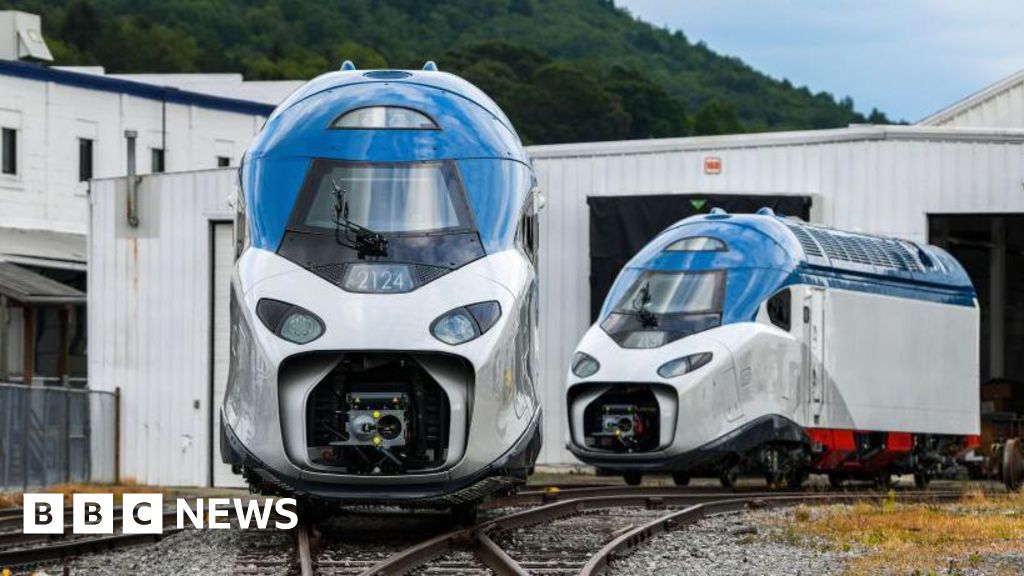Nope.
No. Next question. This ass backward place is going back to the 1800s not the future.
Except we actually had nationwide, first class rail infrastructure in the 1800s. Most of it has since been torn up or laid fallow and left to rot.
We did not have nationwide high speed rail and we still will not have high speed rail.
You, I appreciate your optimism. Though I think you may be a few hundred years off. But I’m sure we will see as America sleepwalks through this.
Honestly, I would settle for a low speed passenger rail network if it could actually get me where I need to go. Which currently it doesn’t.
I love rail. I work with rail. I don’t believe the USA is a candidate for the passenger rail system we’re picturing. Metro rail already exists in population centers with respectable, local capability. NYC, Boston, DC, Chicago, SF/Oakland, Philadelphia, LA, and Atlanta have some pretty healthy stats from their systems. So why can’t they be connected? Because the USA is huge, relatively speaking, and quite empty. Look at a population density map and you’ll see a small drop off moving west as you cross the Mississippi River and a huge drop off after the Missouri. It doesn’t come back in meaningful numbers until the pacific coast. It’s a sizable issue to make sensible routes that effectively cater to very, very spread out city hubs. Lemmy skews towards coastal residency, I bet, from a combo of sociopolitical demographic and, more importantly, the fact that most of the US population lives near the coast. If you’ve ever tried driving across the country, it sucks. There’s neat mountain chains that diversify the topography and ecology, but it’s vastly, widely flat and barren.
“But Japan does it” look at the rail map. It’s much easier to have a central route with many spurs due to the shape.
“OK so Europe then”. Not really. The dreamy European rail network is very heavily biased towards the western half - not unlike how the US network biases the Eastern 1/3.
“But there’s so many accounts of great rail travel, both in US antiquity and modern Europe”. Confirmation bias. How often do you hear someone complain they took an inter national trip and couldn’t find a train? Compare to how often a person reports their great train trip. The trips are great because in a train-based trip, you go where the trains go. This does not speak for the trainless European citizens. This does not speak for the pre-interstate US citizens that had no other choice than to travel by train.
I’m not saying the US rail system is great without need for improvement. It could absolutely be better. Other modes of public transportation are also pretty derelict here. But a system that can’t handle the “last mile” is not going to be effective. Adding onto the issue of bad transportation options outside the Amtrak station in the middle of a city, local infrastructure is typically hostile to non-car travelers. Highways intersecting cultural centers, sidewalks being rare, and spaced-out businesses make walking incredibly unfeasible in a majority of US cities. We can sit and blame the auto industry for lobbying various things in favor of the car, but we can’t immediately undo that. We also can’t change the fact that the big cities are still so far apart.
Look up whatever attractions you want to see and see how many hours of driving they are apart. Even on the dense side, NYC is 4 hours’ drive from DC or Boston. An improved Northeast Corridor (which is home to the upcoming Acela 2/Avelia pictured above) still would only cover 450 miles of a narrow population cluster. The current Acela covers that in 7 hours at best from a mixture of older track, tighter curves, and, of course, stopping to let people go other places. Driving is about 8 hours. From there, though, there’s still the other 3000 miles between NY and LA. So what is really expected of a cross-country rail network? It’s really not surprising that air travel beats it with speed (and the same inconveniences at the destination) and that driving beats it with flexibility (with about the same time requirement but less infrastructure cost).
Aside from that, Amtrak is continuously struggling against freight lines. Amtrak’s cross country capability largely comes from borrowing freight track rather than having dedicated lines. So while freight keeps playing games to steal extra track time, remember that freight is fighting a shitty battle against trucks. Trucks do a better job of fast delivery simply because they drive to the destination. Much less logistics surrounding transfers. Amazon taught us we can have it tomorrow and now it’s expected across all levels of trade. So sure, it’s easy to say build a new track, but that’s a huge, huge cost to fix some train cancelations.
Anyway, I was able to witness the Avelia do speed testing. It’s fuckin cool. Alstom/Bombardier of French TGV fame is behind Acela and Avelia, along with so much more of the US passenger market.
Also, Europe is shifting towards having more cars.
https://ec.europa.eu/eurostat/web/products-eurostat-news/w/ddn-20240117-1
In 2022, the average number of passenger cars per 1 000 inhabitants in the EU was 560. During the decade 2012-2022, the average number increased by 14.3% (from 490 to 560 passenger cars per 1 000 inhabitants).
Italy had the highest number with 684 passenger cars per 1 000 inhabitants and it was followed by Luxembourg (678), Finland (661), and Cyprus (658). Meanwhile, Latvia had the lowest rate with 414 passenger cars per 1 000 inhabitants, followed by Romania (417), and Hungary (424).
Data show that central and eastern EU countries recorded high growth rates between 2012 and 2022. Among the EU countries, Romania registered the highest growth of passenger cars per 1 000 inhabitants (+86.2%; +193), followed by Croatia (+44.8%; +152), Hungary (+40.9%; +123), Slovakia (+40.1%; +135) and Estonia (+39.7%; +181).
Most of Europe’s city road networks were built before the automobile was common. If you look at some of the older cities in the US on the East Coast, you’ll also see narrower streets and less visibility at corners. But most of the roads in US cities are pretty young.
Once you have a layout oriented towards horse and foot traffic, it’s not easy to retrofit it in the way that it is say, with adding electricity to a city when that came along. Can’t just go through and expand the city roads without smacking into buildings.
Using mass transit along a select set of roads and then walking the last mile is less-disruptive to the existing layout, so it’s a reasonable way to deal with older road layouts.
You add a good point that explains a difference I didn’t exactly consider. I talked about how pedestrian-hostile US cities are but never really considered why European cities are friendlier. Duh, the cities largely existed before the cars did. Horses and carriages aren’t far off in size, but their speed is a fraction of the automobile. Funny, because I’m well aware that European cars are tiny because they have to take roads originally sized to beasts’ asses while Americans can make u-turns on the average suburban stroad
Regional networks would be good. But I don’t wanna take a train to California.
Me neither, taking a train through the ocean gets very messy
We do have 1st and 2nd place for best scenic train routes in the USA, each having a start/end destination in California.
Just say’n.
I would love to take a train to CA, if I didn’t work in the soulcrushing US with awful PTO. I would also take it if it didn’t take multiple days longer than driving. Even if it were a day longer from the Midwest, I’d do it.
Speed, reliability, and frequency. Oh and nationalize the fucking railways again, please.








